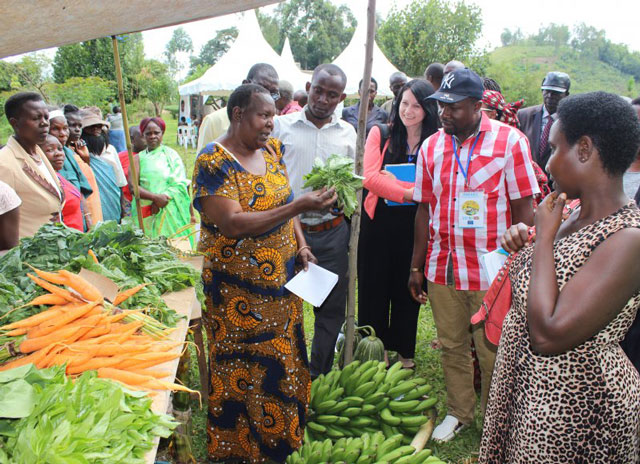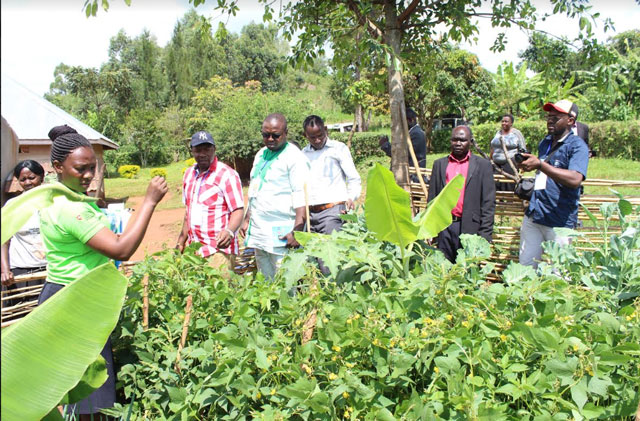
Kasese, Uganda | THE INDEPENDENT | It was a time of great celebration in Lhuhwahwa II village in Kasese district and in Rukomero village in Kyenjojo district in Western Uganda last week as community members came together to celebrate adoption of nutrition sensitive agricultural practices, improved dietary diversity and good hygiene and sanitation practices at household level.
Out of 80 villages that were assessed in the two districts for SNV support and certification, only two Lhuhwahwa II and Rukomero village passed tests on their rate of adoption of nutrition sensitive agriculture, awareness on sanitation and numbers of households consuming five targeted food groups.
Beyond the fanfare that comes with these kind of events is a story of collectiveness and determination by households in the two villages to ensure that families are growing and eating diversified diets. And the evidence is all around the communities.
Everywhere you pass in the two villages, households have planted vegetables comprising of mostly amaranth (dodo), Pumpkins, African egg plants and collard greens (Sukuma wiki) in their backyards, something that was not commonly practised before.
“We thank SNV for helping us realise the importance of eating vegetables and teaching our households how to set up vegetable gardens. I am happy to report to you today that every household in our village has established a vegetable garden from where they get vegetables for their home meals,” Mr Kidemba Jostus Chairperson Local Council I, Lhuhwahwa II Village Kisinga Sub-County Kasese district.
Since 2015, SNV in partnership with the Centre for Development Innovation of Wageningen UR (CDI) and the Royal Tropical Institute (KIT) having been implementing the Sustainable Nutrition for All (SN4A) programme with funding from the Swiss Agency for Development and Cooperation (SDC).
The programme which is now in its second phase aims to improve nutrition outcomes in 17,200 households through adoption of agro-biodiversity and improved dietary diversity at the intra household level.
Checking childhood malnutrition
Inadequate care and feeding practices, food insecurity, an unhealthy household environment and inadequate health services are some of the lead causes of early childhood malnutrition.
Each of these underlying factors of undernutrition are heavily influenced by behaviours related to food production and purchase, intra-household food distribution, care practices and hygiene.
Recognising that improvement in nutritional outcomes is greatly affected by gender roles within households, the project engaged both men and women within the communities to review and address intra-household decision making on food production, expenditure, consumption and allocation;.
It also addressed access to resources and women’s time and workload that can often affect care practices.
To ensure sustainability and scalability of the approach, the project team worked with the local government structures, strengthening their capacity to plan and implement nutrition sensitive strategies.
The team also engaged relevant central government ministries at the national level to provide back stopping support to the Local governments.
Government aided primary schools were co-opted and demonstration gardens showing agro-biodiversity established at the schools and used as community learning centres. Communities were then mobilised to learn from school and supported to replicate the best practices learnt at the school demonstration gardens in their households.

Villages assessed
To qualify for certification and therefore celebration, villages were assessed on three milestones, firstly the adoption of nutrition sensitive agriculture (if they had established a vegetable garden with at least one vegetable and fruit. Minimum adoption rate for certification under this criteria was 80%.
Secondly, on consumption – whether the households were consuming at least three meals daily from the five food groups. Minimum adoption rate for certification under this criteria was 65%.
Finally, on Water, Sanitation and Hygiene (WASH) – to assess how many households owned and were using a latrine and had a functional hand washing facility. Minimum adoption rate for certification under this criteria was 75%.
Out of 80 villages that were assessed in the two districts only two Lhuhwahwa II and Rukomero village passed all the three levels. Many villages were found wanting in WASH, especially in the area of hand washing.
In the second phase of the project, more emphasis is being placed in sanitation and hygiene besides production and consumption of diverse diets to ensure that the project addresses nutrition holistically.
******
SOURCE: SNV MEDIA
 The Independent Uganda: You get the Truth we Pay the Price
The Independent Uganda: You get the Truth we Pay the Price



